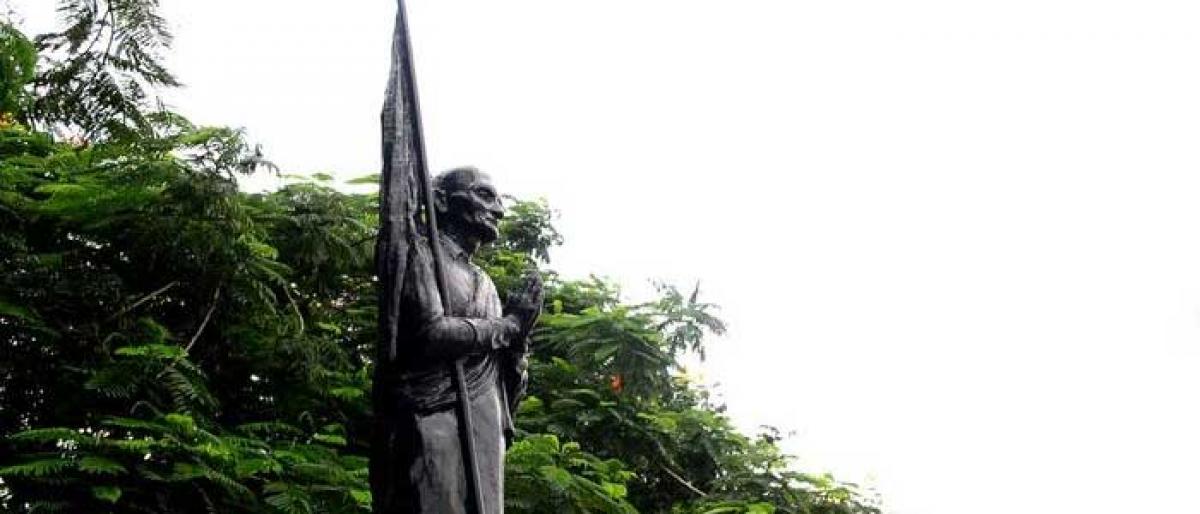Live
- Head Constable Dies by Suicide, Cites harssament by wife and inlaws
- Delhi BJP claims AAP govt will never pay women allowance like in Punjab
- India is 'Mother of Democracy': PM Modi
- ‘One nation, one election’ will undermine India’s federal structure: Mehbooba Mufti
- ‘Bachhala Malli’ trailer heightens anticipation
- Karnataka quota row: Backward Class forum chief warns Lingayat seer over 'tinkering with reservations'
- Tight security arrangements at Group-II examination centers District SP
- Alia Bhatt captures attention in white
- Varun Dhawan talks about ‘Baby John’
- ‘Moonwalk’ trailer promises a quirky heist, love, and loyalty
Just In

As Prime Minister Narendra Modi unfurls the national flag from the ramparts of Red Fort in Delhi on Tuesday morning to mark the 71st Independence Day of India, thousands of invitees to the celebration salute the Tricolour. In schools and colleges, at community centres and road junctions and in State capitals across the length and breadth of India, the national flag flutters and the people sing the
As Prime Minister Narendra Modi unfurls the national flag from the ramparts of Red Fort in Delhi on Tuesday morning to mark the 71st Independence Day of India, thousands of invitees to the celebration salute the Tricolour. In schools and colleges, at community centres and road junctions and in State capitals across the length and breadth of India, the national flag flutters and the people sing the anthem with patriotic fervour.
While almost everyone knows that Rabindranath Tagore penned the national anthem, how many know who conceived the idea of a national flag and unfurled it after five years of research and hard work?
The man behind the monumental effort was Pingali Venkayya, born in a remote village called Bhatlapnumarru in Krishna District of Andhra Pradesh –then Madras Presidency – on August 2, 1876. He was a freedom fighter and a Gandhian to the core.
A multi-faceted personality, Pingali Venkayya was a linguist, geologist and an agriculture expert. He plunged into freedom struggle along with other stalwarts of the day under the influence of Mahatma Gandhi. Gandhi was in Africa when Pingali, at 19, was fighting in the Anglo-Boer war under the British Indian Army.
After his return to the native land, Pingali’s association with Mahatma Gandhi had strengthened. It also gave him a new vigour to pursue his national goals. However, his greatest contribution to the country was giving it an identity through a flag.
There are various accounts about his designing the flag, but what is widely accepted is Pingali had proposed the national flag idea at the Indian National Congress meet in Kakinada on March 31, 1921. With a few minor changes like adding a white stripe between Pingali’s original concept of green and saffron bands and replacing charkha with Ashok Chakra, the Constituent Assembly of India had adopted Pingali Venkayya’s concept of the national flag on July 22, 1947. And, the first Prime Minister of independent India Jawaharlal Nehru unfurled it on August 15 the same year.
Ironically, the 141st birth anniversary of Pingali Venkayya on August 2 had mostly gone unnoticed in official circles; only a nostalgic social media had commemorated him and recalled his last days in Vijayawada where he died on July 4, 1963, in penury – unsung and unhonoured.
The man who sacrificed everything to the nation without aspiring for anything had been ‘honoured,’ of course, with a postal stamp in 2009 and two statues – one in his native village Bhatlapenumarru in 1998 and another at All India Radio Studios in Vijayawada in January this year.
In 2012, the AP Government had nominated Pingali Venkayya for Bharat Ratna but he did not appear to be the deserving candidate for the selection committee. Instead, in 2014, eminent scientist Prof. CNR Rao and cricketer Sachin Tendulkar were honoured with the highest civilian award.
It is customary to recall the services of freedom fighters during Independence Day speeches and remember them. But often, even the veterans from the Telugu states don’t find a place in the scroll of honourable mentions. Is it bias towards South? One wonders.
It’s not just in the case of Pingali Venkayya who deserves a better national recognition than paying lip service on his birth and death anniversaries. Besides freedom fighters like Pingali Venkayya, Alluri Sitarama Raju, Potti Sreeramulu, Tanguturi Prakasam, Kanneganti Hanumanthu, dozens of eminent Telugu scholars, poets, literary luminaries, social reformers have enriched the nation’s social and cultural milieu.
Gurazada Appa Rao, Kandukuri Veeresalingam, Bhogaraju Pattabhi Sitaramayya, Tanguturi Prakasam, Viswanatha Satyanarayana, Ayyadevara Kaleswara Rao, Kasinathuni Nageswara Rao are only a few in an unending list of modern and contemporary Telugu reformers, thinkers and intellectuals. The list will not be complete without the mention of former Prime Minister PV Narasimha Rao. The way he was treated after his death by his party is too fresh to forget.
The shabby treatment meted out to some of the Telugu greats was not confined to the Central Government alone. The Telugu states and their respective leaders too are responsible. Often, extraneous considerations rob the deserved of their opportunities for recognition and fame.
It is the time the Telugu people start asserting that they too were very much part of the freedom struggle and their contribution to the movement was in no way small. Unfortunately, there is an impression among some political leaders that only North was in the forefront and the rest of the country followed its leaders.
Pingali Venkayya is one example to disprove such claims. What is needed is recognition at State and Central level.
First, let the AP government start tracing his family members and ‘rehabilitate’ them in a suitable manner. As the saying goes, if we don’t respect ourselves, nobody will.
By:Madhusudhana Rao S

© 2024 Hyderabad Media House Limited/The Hans India. All rights reserved. Powered by hocalwire.com







